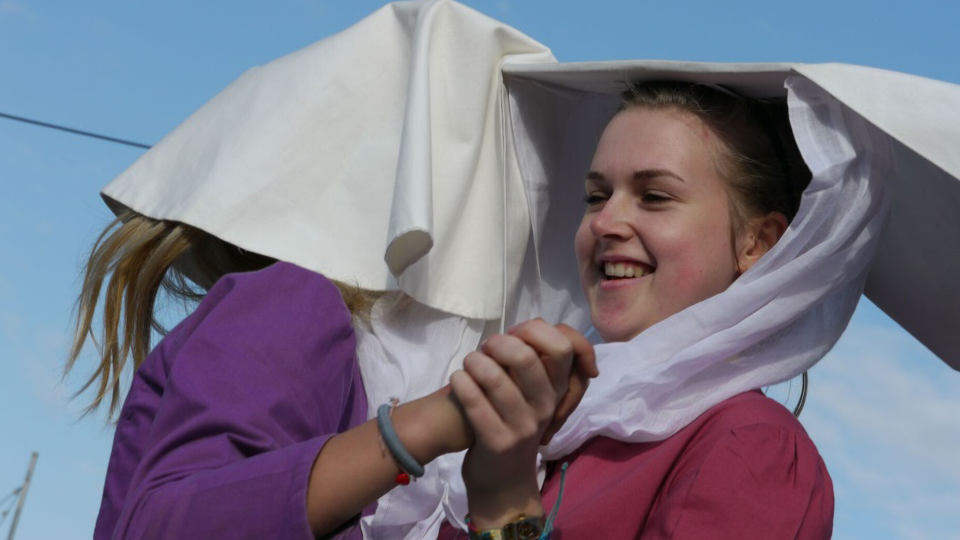
In this article Merv Davey takes a look at Cornwall’s oldest musical genre and explores its interaction with our social history.
This Cornish Story is about the folk dance traditions that have evolved in Cornwall and the music that goes with them. Just as the dance traditions mirror Cornwall’s social history so the tunes that accompany them reflect the influences that have created the modern repertoire of Cornish dance music.
The story starts with the Medieval Cornish mystery plays, the ‘Gwary Myr’. They marked a renaissance of the Cornish language in the middle ages and also give us context for early dance music in Cornwall. They were a mixture of public entertainment, religious education and political comment and usually performed promenade style in the round. During the course of the play and particularly at the end, musicians are called upon to play for dancing:
“Pybugh menstrels volonnek may hyllyn donsia dyson”
Pipe ye hearty minstrels that we may be able to dance forthwith
(From the 16thcentury Mystery Play Beunans Meriasek)
The instructions in the mystery plays do not describe the music or the dances except to indicate that they should be fast and hearty. The medieval Cornish carols are strongly linked culturally to the mystery plays so that tunes collected in Cornwall, like ‘Tomorrow Shall Be My Dancing Day’ and ‘I Saw Three Ships’, give us a feel for the music that was played.
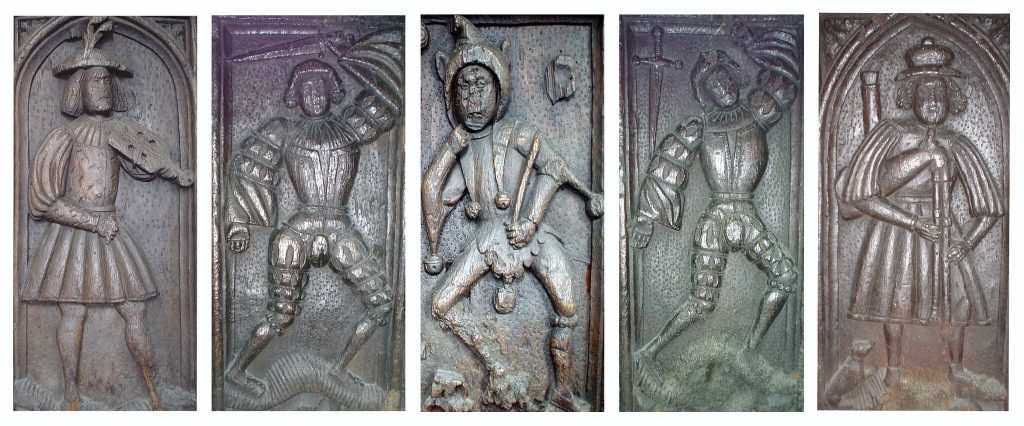
Medieval carvings in Cornish churches also give us a window into the musicians and their instruments. The minstrels carved on the East wall of St Mary’s Church in Launceston boast a harp, a crowd (a form of early fiddle in Cornish) and a bagpiper, together with a selection of percussion and horns. The magnificent bench end carvings in the Church at Altarnun even include some dancers accompanied by a piper and crowder. Two dancers have swords and are very similar to drawings of the dance called ‘The Mattachins’ in French dancing tutor Arbeau’s ‘Orchesography’ published some 70 years later. Cornwall’s central position on the medieval sea routes created the perfect environment for cultural exchange with Europe.
Click below to hear Merv Davey play ‘The Mattachins’ on his Cornish Bagpipe, inspired by the carvings at Altarnun Church.
Several of the mystery plays are thought to have been written at Glasney College in Penryn, the cultural centre of the medieval Cornish world. The college was dissolved and destroyed by the Tudors in 1548 to bring the Cornish in-line with the religious and civic culture of the crown. This provoked a rebellion in Cornwall which attracted a bloody reprisal from the Tudors and thousands of people were executed. This is sometimes seen as a fatal blow to Cornish language and culture, but many traditions, folk dance among them, simply moved away from the official religious and civic domain to live on within the customs of the ordinary Cornish people.
Unwitting testimony to the continuing tradition of circle dances in the 18th century is provided by Dr William Borlase in his ‘Antiquities of Cornwall’ (London, Byer & Nichols, 1769). He explains that the stone circles in Cornwall are called Dawns Men, meaning dance of stones, as they provide an area for dancing. He comments that, “in a circular figure there is a very ancient dance or play still practised amongst the Cornish.” Footnotes explain that this dance is called ‘Tremadheeves’ but sadly, he does not provide a description.
Cornwall’s early engagement with the industrial revolution is part of the Cornish profile and much celebrated. In many places, industrialisation resulted in the decline of rural communities which affected the continuity of tradition between generations. The nature of the early mining industry in Cornwall was such that communities remained in place as it developed around and sometimes literally below them. This served to preserve continuity of folk customs, providing rich pickings within Cornwall as enthusiasm for recording and collecting folk traditions grew in the 19th century.
Scoot Dances
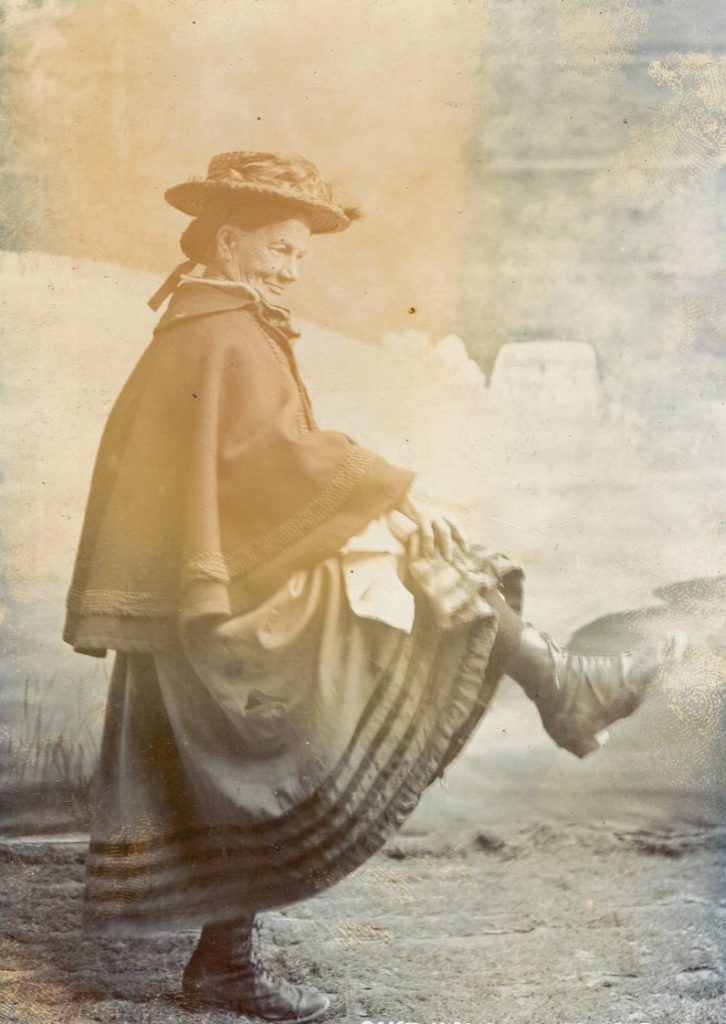
The early folklorists and antiquarians failed to recognise the dynamic nature of folk tradition. They were collecting and recording what they saw as the last vestiges of a fading traditional culture, when in fact these very traditions were evolving and changing quite robustly around them. Cornish step dancers took full advantage of the satisfying clacking sound of hard soled footwear needed for the mining and quarrying industries. This sound was enhanced further when metal plates were added to the toes and heels to increase the life span of the footwear. In Cornish dialect these metal plates were called ‘scoots’ and this term eventually transferred itself to the dance tradition itself, so that the distinctive style of Cornish step dancing became known as ‘scoot dancing’.
The atmosphere of Cornish scoot dancing is captured in this description of a 19th century wedding:
“Presently the fiddle struck up with a jig ‘Les have the double shuffle, Uncle Will,’
said the young people. Up he jumped as lively as a kid, though he was near eighty,
and footed it out to the delight of all. Young Jan followed, making the fire fly from
the heels of his boots, like flashes of lightning; and all the company were quickly
whirling, in reels, without much order.”
(William Bottrell,Traditions and Hearthside Stories of West Cornwall 1873)
The informal nature of scoot dancing meant that it played a low public profile but nevertheless remained as a living tradition within some families, especially in North Cornwall until the latter part of the 20th century. At which point it was eagerly seized upon by dance groups and enthusiasts looking for Cornish dances to choreograph as displays on the emerging Celtic festival scene. Ten or so dances with a number of different steps were originally collected and since then a large number of new dances have been written using the traditional steps to provide the 12th century Cornish scoot dancer with a wide repertoire.
Click below to hear ‘Resyas’, a percussion duet with Cornish scoot dancers ‘Tan Ha Dowr’.
Guize Dancers
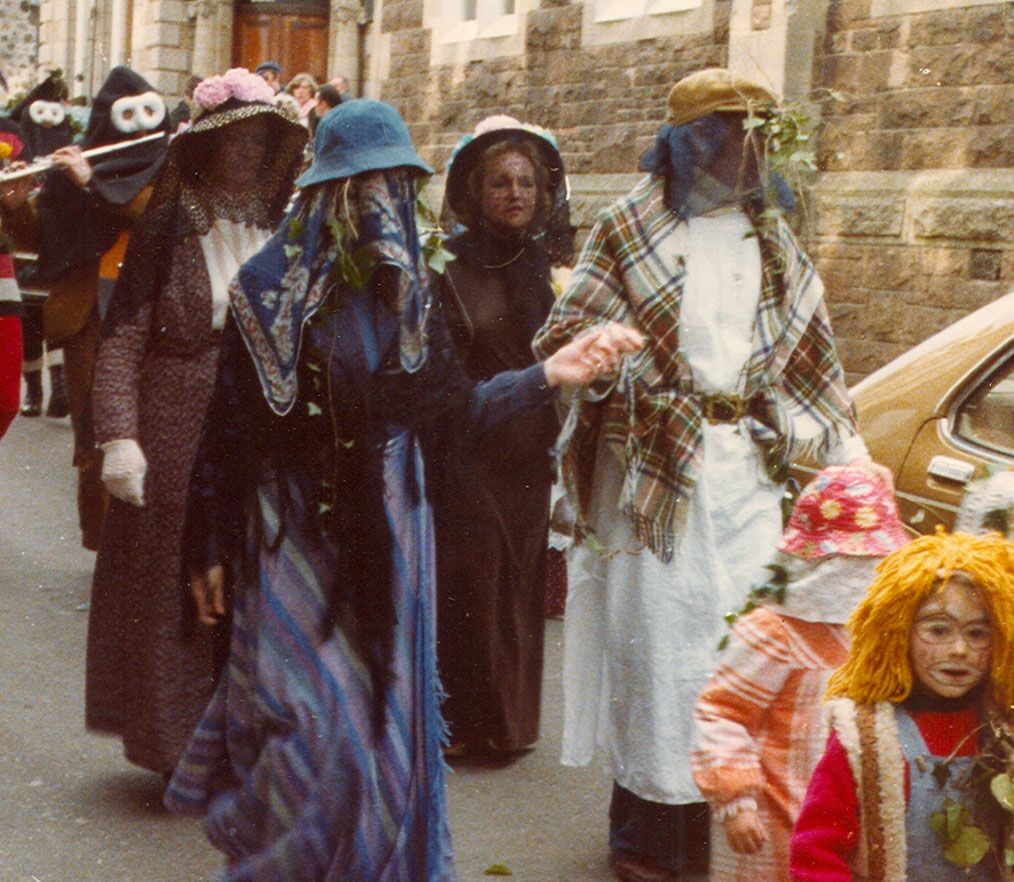
The Cornish Guize dancer can be seen as Cornwall’s answer to the English Morris; both have their roots in the pan-European medieval melting pot of folk traditions and both evolved to take on their own distinctive form in the 19th century. The folklorists of the time saw the Cornish Guize dance tradition as having its origins in the Cornish mystery plays. It is difficult to argue that the bizarrely costumed anarchy of Guize dance does not echo the spirit of medieval drama. The Cornish cultural revivalists of the 1920s and 1930s were keen to point out that ‘Guize’ was pronounced Geeze in Cornwall. This is a dialect term but it comes from the Cornish language word Geys meaning a jest and Geysor a jester or fool.
Guize dancing is not so much a specific dance style but a package of traditions, including dance, that centre around a procession or dramatic custom wherein the players disguise themselves with veils, masks or blackened faces and attire themselves in mock posh costume or cross dress. Guize dance traditions often have specific songs or tunes associated with them, for example Helston’s ‘Hal An Tow’ and Padstow’s ‘Obby Oss’. ‘Bodmin Riding’ is the processional tune for the Raggadassiow when they perform the Bodmin play and the same tune accompanies the St Ives Guize dancers, but under the name ‘The St Ives Well Procession’.
The Madron Guize dance rounds off with the delightfully named ‘Turkey Rhubarb’ and shows how Cornwall’s maritime heritage can be reflected in folk tradition. The dance is a kind of Mazurka which started out in Eastern Europe and ended up in Brittany before hopping across the Celtic sea to Cornwall and then to Ireland. The Irish version of the dance is called ‘Father Murphy’s Topcoat’ and is so similar to the Cornish one that the tunes and dances can be interchanged.
Click below to hear ‘Turkey Rhubarb’ played by North Cornwall Ceili Band.
Furry Dances
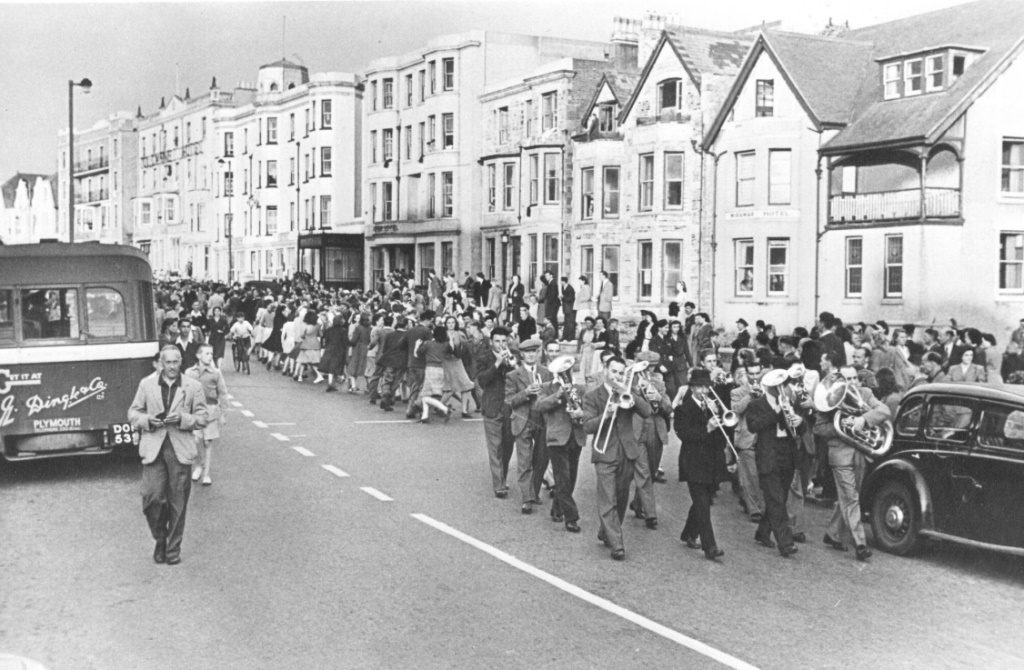
Just as Guize dancing tends to be associated with certain dates in the calendar so does another long-standing Cornish dance tradition, the Furry dance. The Furry dance is essentially a processional dance for couples with a certain number of bars travelling forward and a certain number of bars performing a figure on the spot. Many towns and villages have their own Furry Dance. A description of Helston’s Furry dance on 8th May appears in the Gentleman’s Magazine of 1790 and there are several early 19th century records of others taking place around West Cornwall in early May. It was clearly seen as a long-established Cornish tradition in 1801 when adopted for the first John Knill ceremony in St Ives. This ceremony takes place every five years on 25thJuly and commemorates the eccentric John Knill, erstwhile mayor and customs collector in St Ives.
Although early 19th century histories locate the Furry dance largely in the West, it seems likely that it was always a Cornwall-wide tradition. It was certainly widespread, with different dances to be found across Cornwall in the early 20th century. New dances, together with the accompanying tunes, continue to be composed today.
Serpent Dances and Snail Creeps
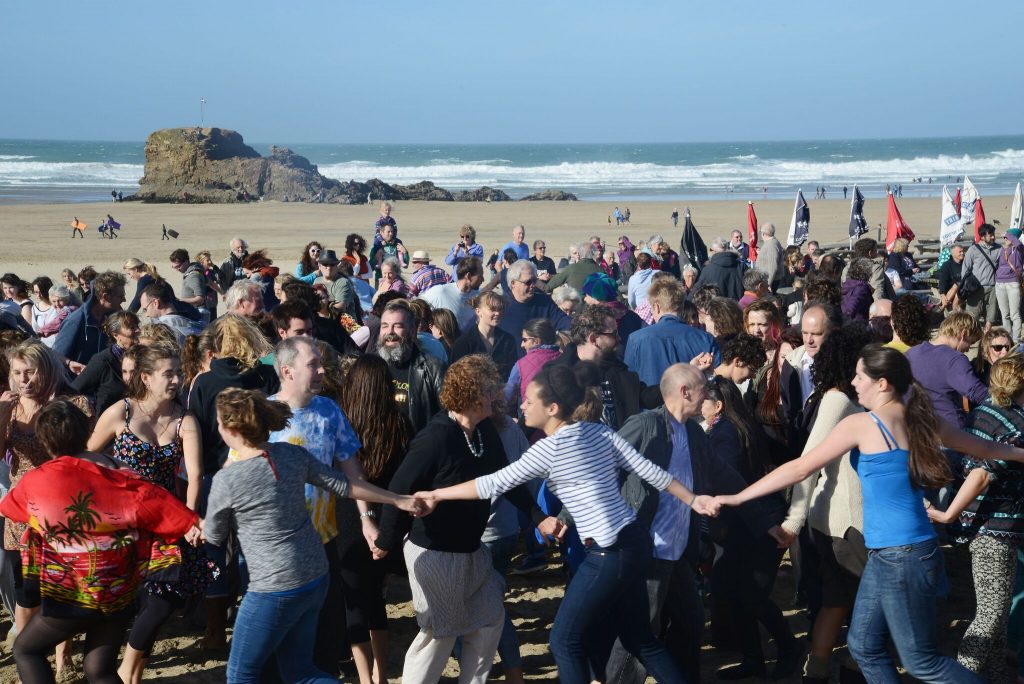
(Photo: courtesy of Perran Tremewan)
A quite different aspect of Cornwall’s social history is reflected in the dance traditions associated with the Cornish Tea Treat. In parallel with the industrial revolution, and perhaps partly in response to the negative social impact of unbridled capitalism, Cornwall embraced radical nonconformist religion with great enthusiasm in the 19th century. One of the devices used to counter less temperate social activities was the encouragement of the village feast days and Tea Treats. Older customs such as holy well pilgrimages and saint’s days were firmly connected with the developing Cornish cuisine of cream teas, pasties, saffron cake and a range of other delights. Two particularly striking dance customs were associated with the Tea, the Serpent Dance and the Snail Creep.
The Serpent Dance is a direct descendant of the medieval Farandole and features a line of dancers spiralling around, weaving in and out and ‘threading the needle’ as the last couple make an arch for the lead couple to double back through. The Cornish Tea Treats took this dance to a new level by engaging several hundred people into one long line and placing a full brass band in the lead. The Snail Creep is a dance for couples who form a long procession, again of several hundred people, following the band. The procession is led by two people holding out branches like the tentacles of a snail and follows various spirals and convolutions to represent a snail shell. The Snail Creep has been revived as part of the Rescorla Festival each July. Rescorla is a small village on the Eastern edge of Cornwall’s Clay Country and has its own traditional tune aptly named the ‘Rescorla Snail Creep’.
Listen to the ‘Rescorla Snail Creep’ from the Rescorla Festival below.
Cornish Social Dance
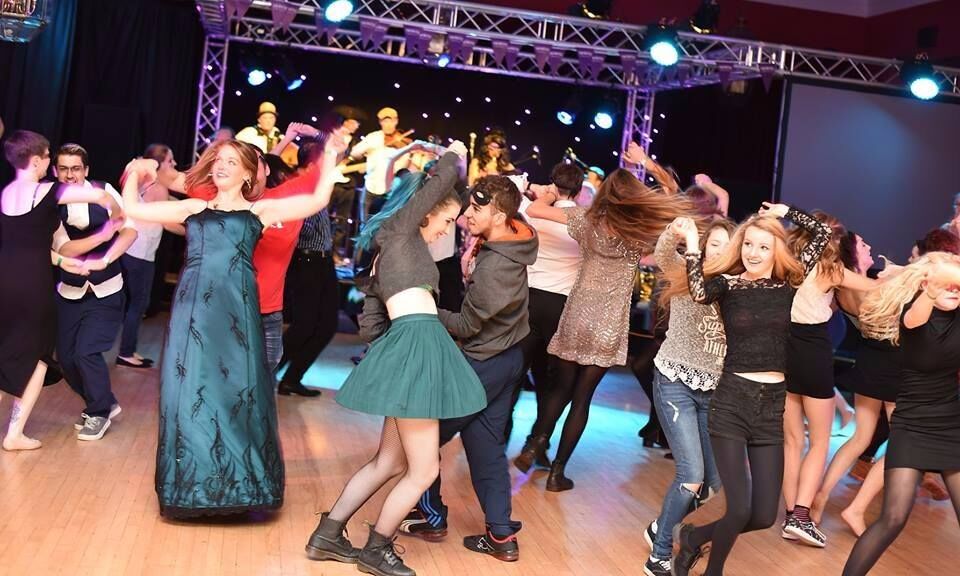
There is a sense in which social dance in Cornwall embraces all of the above as well as reflecting Cornwall’s geography and cultural connection with the other Celtic nations. In Cornish dialect the term for a social or barn dance was Troyl. It was derived from the Cornish for a whirl, spiral or reel and it can be seen that this aptly describes social dances like the Serpent. During the 21st century, the word Troyl has been joined by Ceilidh and Nos Lowen, borrowings which reflect Cornwall’s Celtic affinities. Ceilidh is a Gaelic word for a gathering, whereas Nos Lowen and Fest Noz derive from the Welsh and Breton, respectively, for a night time party.
As well as what were described as the “old Cornish dances” like the Serpent and the scoot dances, the 19th century Cornish Troyl adapted dances from the country houses of the gentry. The manuscript of John Old, dancing master for the established gentry and newly rich industrialists of Par, provides a window into this world with music and notes for the dances (See Mike O’Connor and Alison Davey, ‘Dancing Above Par’, An Daras Folk Arts Project, 2003).
Cornish dance continues to play its traditional role in events celebrating the seasonal calendar, as well as a communal activity for weddings and party time in general. In the 21st century, Cornish dance display groups are regularly invited to represent Cornwall at major festivals, such as the Festival Interceltique in Lorient, Brittany and the International Folk Festival at Sidmouth. Just as the dancers travel, so do the dances and music. At the time of writing there are groups displaying Cornish dances in Russia and Brazil, as well as a healthy interest in Cornish traditional music and dance across the Diaspora in Australia and the USA.
You can find the first article in the Music Kernow series here. You can also follow Cornish Story on Twitter and Facebook.
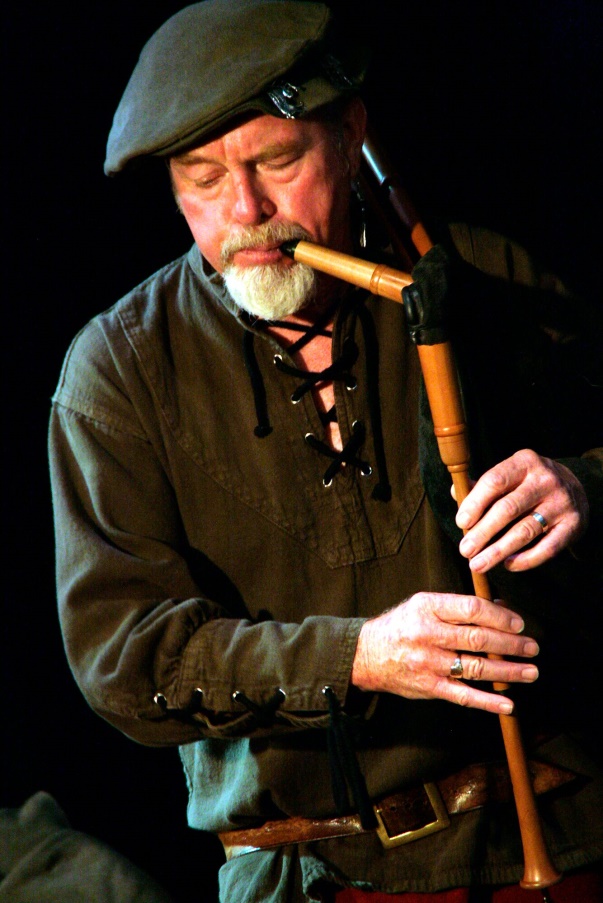

Beautiful website – and great commentary. Thank you for all you do to promote Cornish folk traditions!